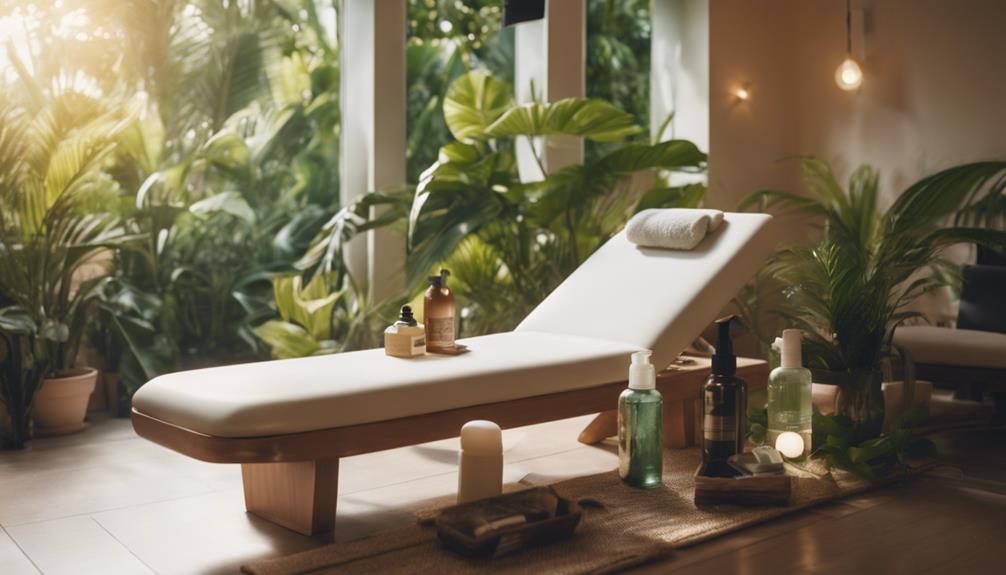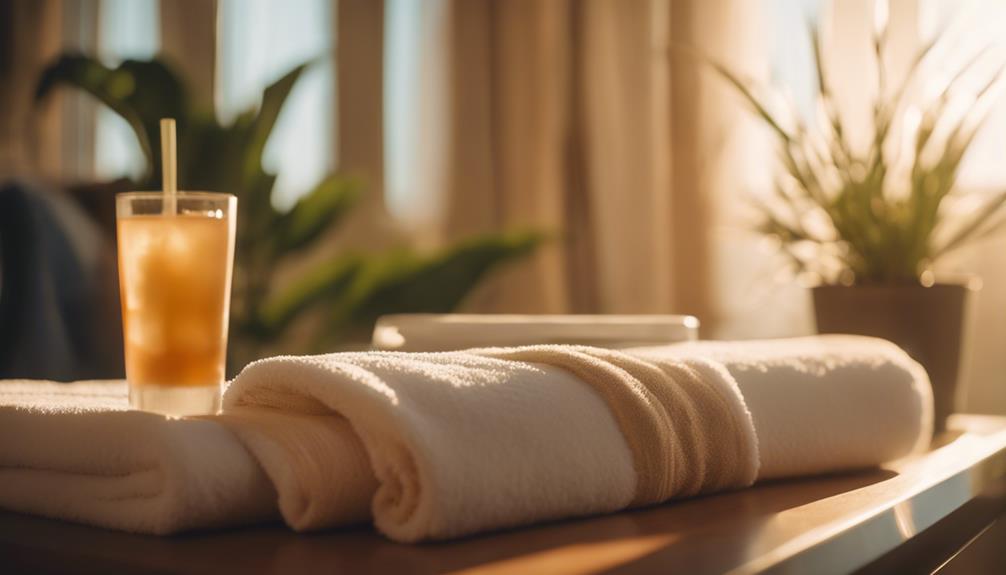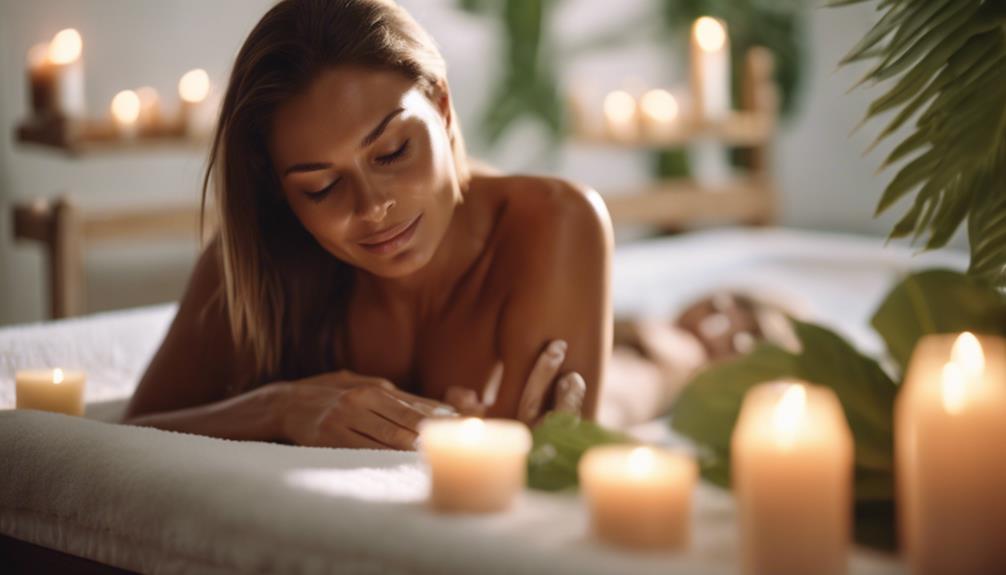To ensure a safe salon tanning experience, it is important to begin by exfoliating your skin for an even application. Using an oil-free moisturizer can help keep your skin hydrated and aid in melanin production. When selecting a tanning bed, opt for one with maximum UVA and minimal UVB exposure, and always remember to wear protective goggles. Start with shorter sessions to assess how your skin reacts, gradually increasing the time as needed. Be vigilant for signs of overexposure, such as redness or discomfort, and have hydrating lotions on hand. Proper preparation and care can make a significant difference in your tanning results, and there is plenty more to explore to enhance your experience. Discover the secrets of tanning accelerators to expedite the tanning process and achieve a deeper, longer-lasting tan. These products can improve your skin’s natural tanning abilities and create a more even, golden glow. When used alongside safe tanning practices, tanning accelerators can be a valuable tool in achieving your desired bronzed look. It is advisable to consult with a professional to determine the best products and methods for your specific skin type. For even safer indoor tanning, it is important to be informed about some key facts. Did you know that tanning beds emit UVA rays, which can penetrate deeply into the skin and lead to premature aging and skin damage? Additionally, it is essential to understand that tanning beds do not offer a safe base tan to prevent sunburn. In fact, all forms of tanning, whether from the sun or a salon, increase the risk of skin cancer. Keep these safer indoor tanning facts in mind as you pursue a bronzed glow.
Key Takeaways
- Always exfoliate your skin before tanning to ensure a smooth and even application.
- Choose a tanning bed that offers maximum UVA and minimal UVB exposure for safer tanning.
- Start with shorter sessions and gradually increase duration based on your skin's reaction to prevent overexposure.
- Use protective goggles and SPF lip balm to safeguard your eyes and lips from UV damage.
Tanning Preparation Essentials
Before you hit the tanning bed, make certain to prep your skin properly to achieve a smooth and even tan.
Start by exfoliating to remove dead skin cells; this helps your tan develop evenly.
Next, apply a moisturizer that's free from oil-based products to hydrate your skin without causing any issues during tanning. This step supports your skin's natural melanocytes, enhancing melanin production for a deeper tan.
It's also essential to understand the tanning bed's role in vitamin D synthesis, promoting overall skin health.
Finally, follow a prep checklist to verify you've covered all bases, setting yourself up for the best possible tanning results.
Proper preparation makes all the difference in achieving that desired sun-kissed glow!
Skin Care Before and After
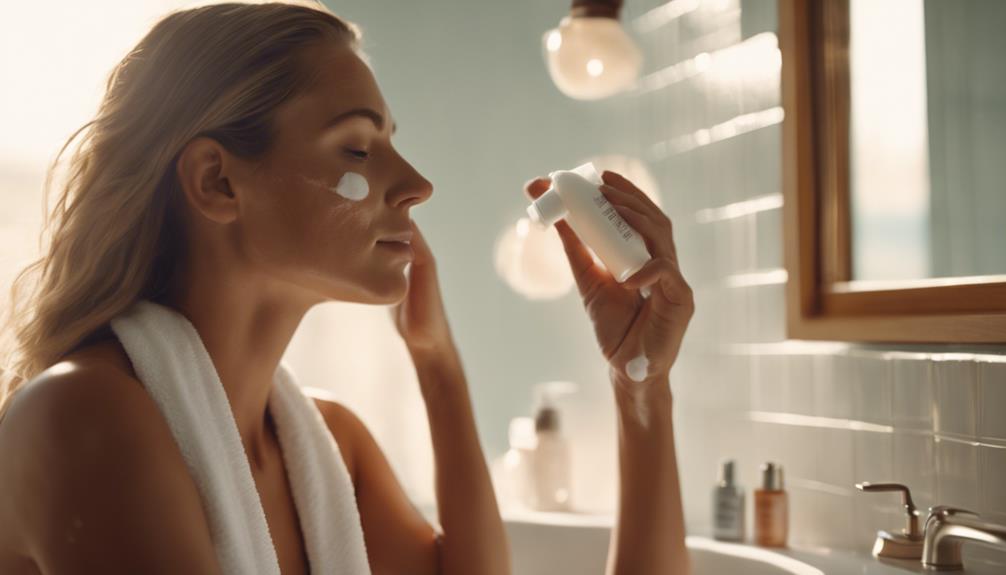
Preparing your skin with the right care before and after tanning is key to maintaining a beautiful, even glow.
Start by exfoliating to remove dead skin cells, ensuring a smooth canvas for your tan. Apply a hydrating moisturizer, but steer clear of oil-based products that could interfere with tanning.
Post-tan, keep your skin nourished with a gentle, chemical-free moisturizer to avoid dryness. Drink plenty of water to help your skin recover and maintain that radiant look.
A few days after tanning, gently exfoliate to prevent patchiness while allowing your tan to fade evenly. Finally, avoid outdoor tanning products after salon sessions to achieve the best results.
Consistent skin care will keep your tan looking stunning longer!
Understanding UV Exposure Risks
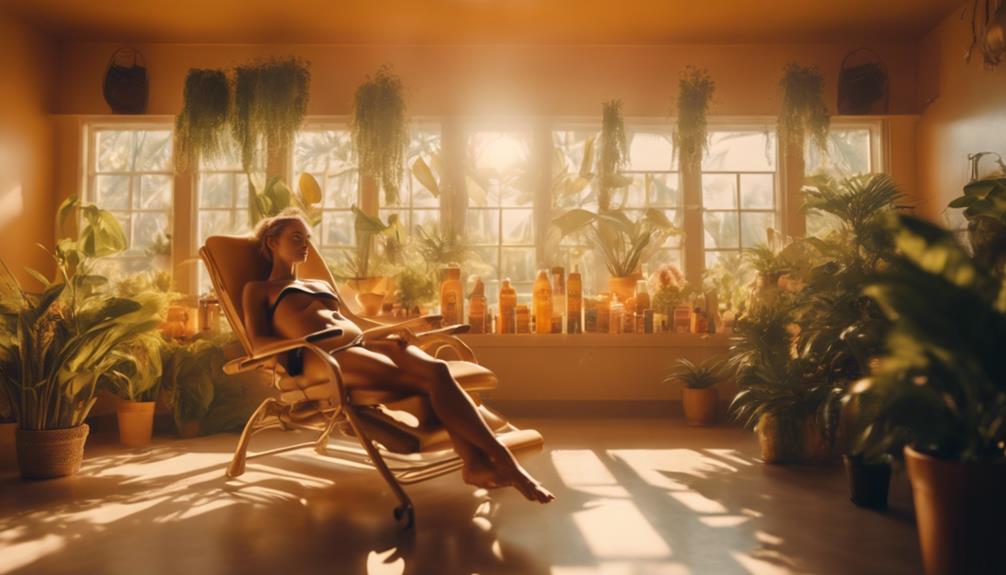
Understanding the risks of UV exposure is essential for anyone looking to achieve a safe and effective tan.
UV rays can cause skin damage and increase your risk of skin cancer, so it's important to assess your skin type and know your limits.
Always check the UV index before tanning to gauge the appropriate exposure level for your skin.
Consider using tanning lotions that provide hydration and protection against UV damage.
It's also wise to consult with a skincare professional for personalized advice tailored to your skin type.
Remember, moderation is key; don't exceed recommended session durations to minimize your risk of overexposure and guarantee a healthy tanning experience.
Prioritize your skin's safety while enjoying the benefits of tanning.
Recognizing Overexposure Symptoms
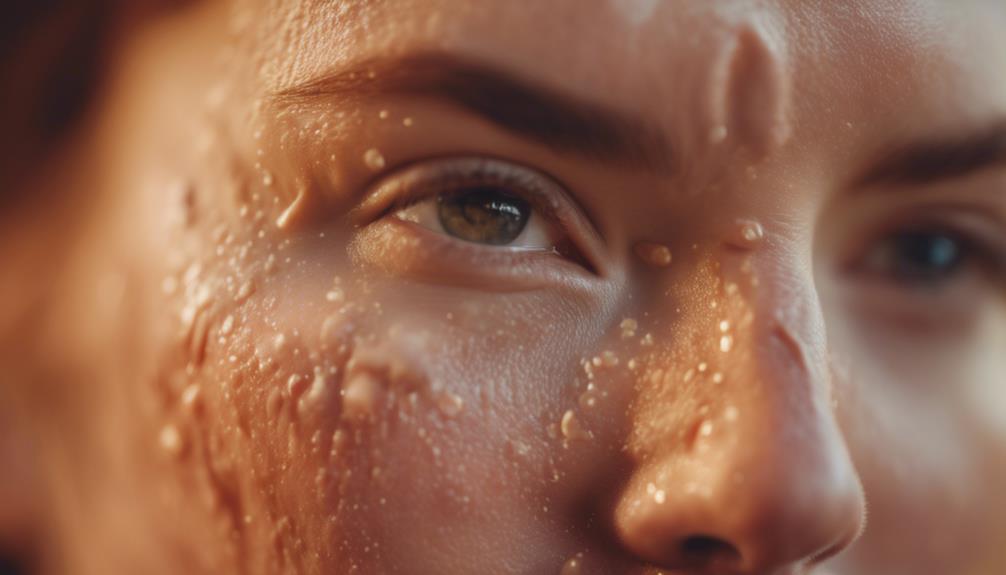
Recognizing the signs of overexposure is essential to ensuring your skin stays healthy and protected during tanning sessions. You should watch for symptoms like noticeable redness, discomfort, or skin blistering, all indicating you've had too much UV exposure. If you experience dizziness or nausea, it's a clear sign to stop and hydrate.
Here's a quick reference table to help you identify overexposure symptoms:
| Symptoms | Action Needed |
|---|---|
| Redness and discomfort | Stop tanning, hydrate, cool skin |
| Blistering or peeling | Seek medical attention |
| Dizziness or nausea | Rest, hydrate, consult a doctor |
| Sunburn-like symptoms | Apply soothing lotion, avoid UV |
Stay alert to these signs to maintain your skin's health and enjoy safe tanning!
Selecting the Right Tanning Bed
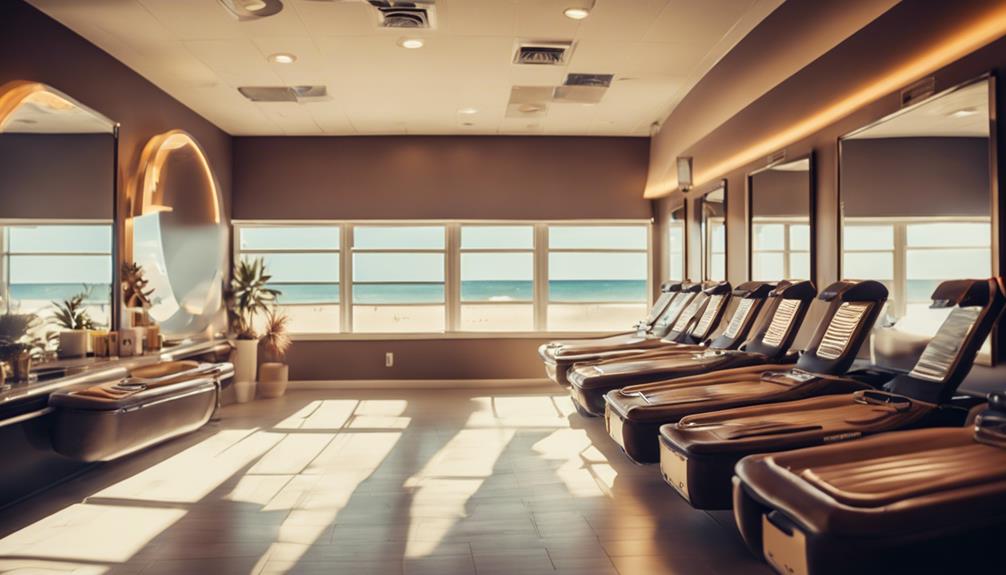
Selecting the right tanning bed can make a significant difference in achieving a safe and even tan while minimizing the risks associated with UV exposure.
Look for beds that offer maximum UVA and minimal UVB, as UVA rays provide instant color without excessive burning.
Consider beds equipped with after-bronzers for a more uniform tan. If you want thorough coverage, choose options with side and shoulder tanners.
Always prioritize eye protection with proper goggles to shield your vision.
Finally, verify the bed aligns with your skin type and tanning goals.
Managing Session Durations
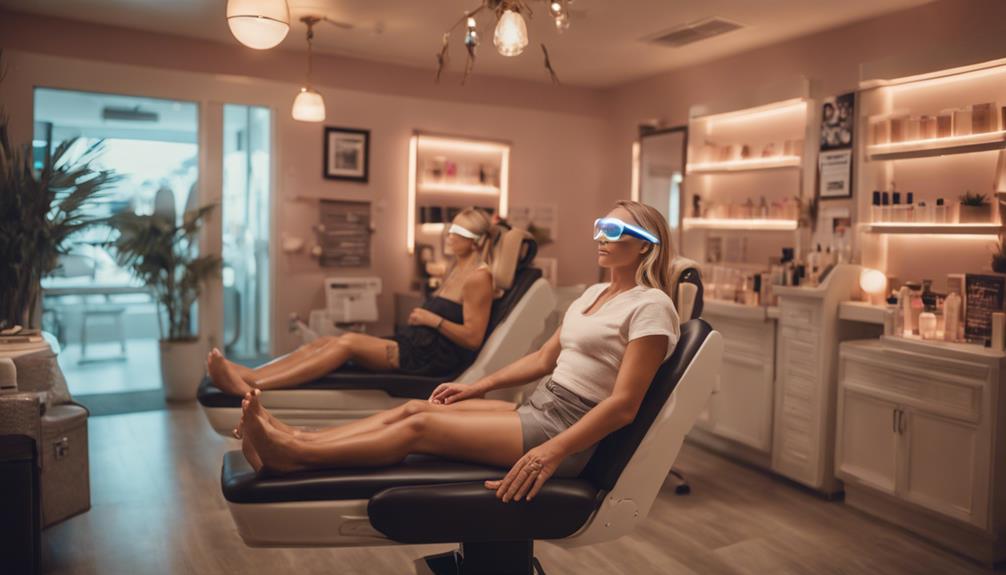
To guarantee a safe tanning experience, it's important to monitor your session durations based on your skin type and the tanning bed's intensity. Overexposure can lead to skin damage, so knowing when to step out is vital.
Here are some tips to help you manage your tanning sessions effectively:
- Start with shorter sessions if you're new to tanning or have fair skin.
- Gradually increase your time in the bed, paying attention to how your skin reacts.
- Stick to the recommended duration specific to your skin type—typically between 6 to 20 minutes.
Eye Protection and Safety Gear
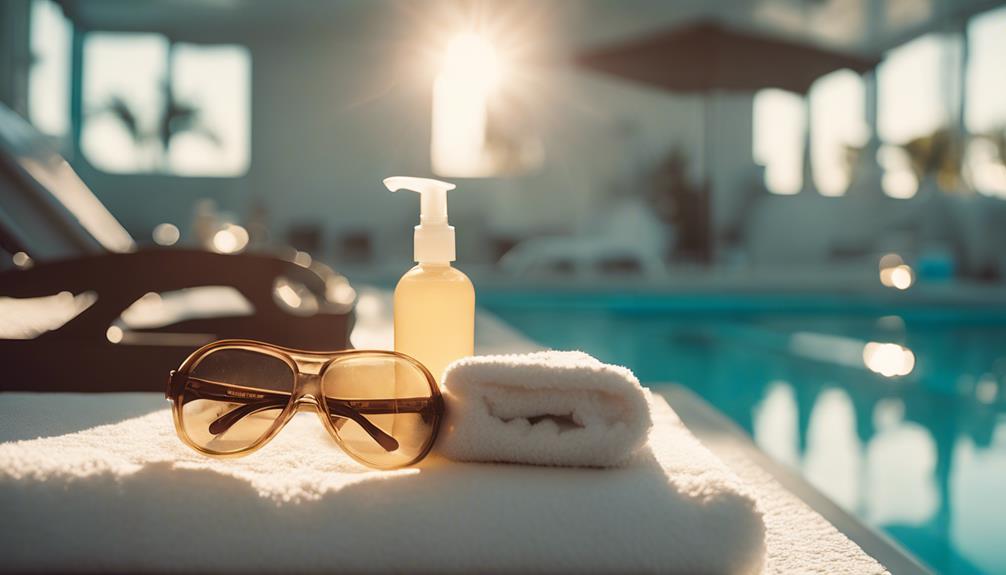
Eye protection is essential during tanning sessions to safeguard your vision from harmful UV rays. Always wear protective goggles specifically designed for tanning. These goggles help prevent raccoon eyes and shield your eyelids, which are too thin to block UV exposure.
Avoid wearing contacts, as they can react adversely to the tanning environment. Don't forget about your lips; apply an SPF lip balm to protect them from UV damage.
Additionally, consider wearing protective clothing or using tanning lotions that hydrate your skin and enhance bronzing effects. By prioritizing eye protection and using proper safety gear, you can enjoy your tanning sessions while minimizing risks and keeping your skin healthy.
Resources for Safe Tanning Practices
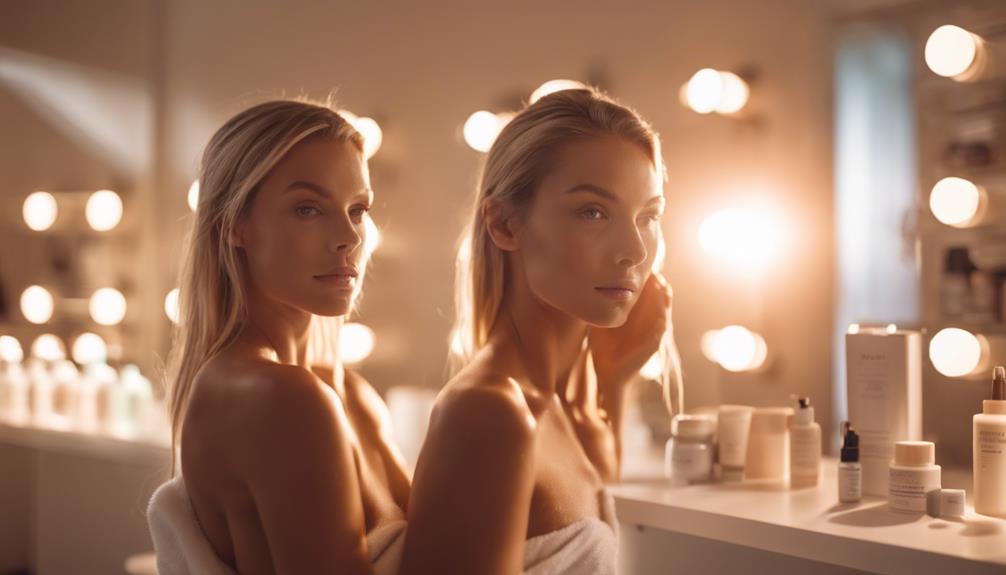
Numerous resources are available to help you practice safe tanning and achieve the best results while protecting your skin. Utilizing these tools can guide you toward a healthier tanning experience.
- Tanning Bed Guidelines: Research and follow the recommended usage for your specific skin type.
- Skin Type Assessment Tools: Use online quizzes to determine your skin type and its UV tolerance.
- UV Index Apps: Download apps that provide real-time UV index updates to help you plan your sessions.
Frequently Asked Questions
How Often Should I Tan for the Best Results?
For the best results, you should visit the tanning salon every 1-3 days initially. After achieving your desired color, maintain your tan with weekly sessions to keep it looking fresh and vibrant.
Can I Use Makeup Before My Tanning Session?
You shouldn't use makeup before your tanning session. It can block UV rays and lead to uneven results. Instead, cleanse your skin thoroughly to guarantee an even tan and better absorption of tanning products.
Are There Age Restrictions for Using Tanning Beds?
Imagine a garden flourishing under the sun; similarly, age restrictions for tanning beds exist to protect your skin's delicate blooms. Generally, you must be at least 18 years old to use tanning beds safely.
What Should I Do if I Miss a Tanning Appointment?
If you miss a tanning appointment, don't stress. Reschedule as soon as possible, and adjust your tanning routine. It's better to wait and follow your skin type's needs than rush back too soon.
Can I Tan if I'm Using Certain Medications?
You should consult your doctor if you're using certain medications, as some can increase sensitivity to UV rays. It's important to prioritize your skin's health and avoid potential adverse reactions while tanning.
Are Tanning Accelerators Safe to Use in Salons?
Looking to achieve a sun-kissed glow quickly? Tanning accelerators secrets unlocked! While they can speed up the tanning process, it’s essential to use them cautiously, especially in salon settings. The safety of these products is a topic of concern, as some may contain chemicals that can be harmful to the skin.
Conclusion
In the pursuit of that radiant tan, balance is key. You want to bask in the sun-kissed glow without risking your skin's health.
By preparing properly and prioritizing safety, you can enjoy the warmth of the tanning bed while minimizing potential damage.
Remember, a beautiful tan shouldn't come at the cost of your well-being.
With the right knowledge and precautions, you can achieve a stunning look that lasts—glowing both inside and out.
